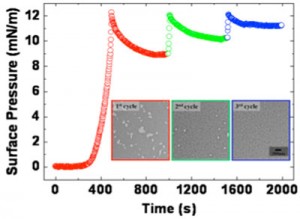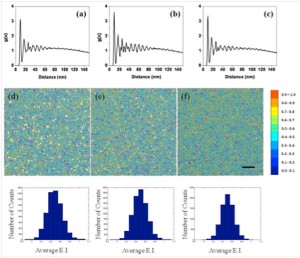Nanoparticle Self-assembly
- Category: Nanotechnology
- Tags: Francesco Stellacci, Jin Young Kim
The success of nanoparticles (NPs)-based devices requires reliable fabrication methods for well-defined, defect-free self-assembled NP structures. NP self-assembly is a process governed by an interplay between many inter-particle interactions, such as core-core van der Waals and dipolar attraction forces as well as interactions due to the ligand shells, which can interpenetrate (known as interdigitation). The result of this delicate balance between strong interactions is often kinetically hindered, hence the attaining and recognition of an equilibrium structure becomes challenging.
We have demonstrated that cyclic compression and relaxation in Langmuir NP monolayers provide a novel annealing approach for equilibrating self-assembled 2D ordered structures of NPs [1] as in Figure 1. These cycles affect the crystal’s long-range order by annealing part of its defects, and its short-range order is improved by increasing the ligand interdigitation and making it more homogeneous, as Figure 2 shows. Furthermore, we are exploring self-assembling behavior of NPs with complex ligand systems.
- Figure 1: Surface pressure-time isotherm curve for the cyclic compression/relaxation processes in a Langmuir NP monolayer. Inset: TEM images of dodecanethiol-gold NP monolayer obtained from 3 compression cycles at surface pressures of 12 mNm-1.
- Figure 2: Structural order in NP monolayer structures obtained from 3 compression cycles at 10, 11, and 12 mNm-1 shown by the pair-distribution functions (a to c) and ligand interdigitation analysis (d to f).
- J. Y. Kim, S. Raja, and F. Stellacci, “Evolution of Langmuir Film of Nanparticles through Successive Compression Cycles,” submitted for publication. [↩]

